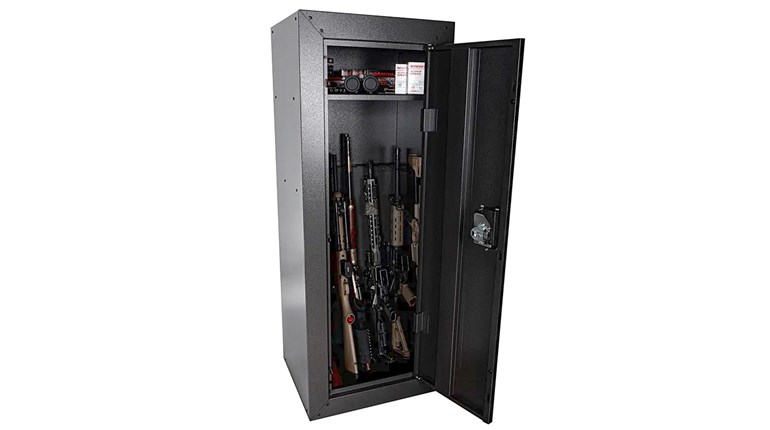
Taking the time to study your range brass can reveal potential problems with your firearm and/or your ammunition. For example, case-head swipe or a popped primer (as above) can be immediately diagnosed on the firing line.
About 10 years ago, I ran into an ammunition issue I had not seen before. I was handloading for an AR-15 and began noticing gouges or swipe marks on the case head. Any case-head deformation is generally looked at as an indication of excessive pressure, especially when the ammo is fired in a bolt-action rifle. However, I was reasonably certain my loads were below maximum—at least that is what the data and velocities were telling me.

To be sure, I called some folks who should have been able to explain what I was seeing. The most common response was something like, “Hmm, that’s odd.” Finally, I got a smart guy from Western Powders on the phone and he explained the phenomena of case-head swipe, and the difference between a blown primer and a popped one.
Granted, a decade later, anyone who’s been shooting AR-style rifles a lot probably already knows all about these things. However, new shooters and new reloaders enter our ranks every day, and this information might be helpful to them. After all, its imperative we have a good understanding of any pressure-related issues our firearms might be experiencing before they become full-blown problems.
The Blown Primer
Let’s start with the most dangerous of the three, the blown primer. A blown primer occurs when the chamber pressure reaches a point to where the cartridge case deforms so much it can no longer hold the primer in place. The result is the primer is ejected from the pocket while pressure is at its peak. A blown primer can be an early-warning sign that pressures are beyond maximum. However, do not expect to see a blown primer before you reach excessive pressure. It can be a sign, but may not occur before you blow up your gun.
Generally, a blown primer is not dangerous. However, because pressure is at its peak when a primer is blown, hot gasses and debris are blown back through the flash hole, into the mechanism of the rifle, which is not intended to deal with high pressure and hot gasses. These gasses can be forced into the face of the shooter—one of the main reasons shooting glasses should always be worn.
What might surprise you is that blown primers are not something that only occurs with handloads. I’ve seen a blown primer with factory ammunition on numerous occasions. In some instances it was an ammunition problem, in some it was a gun problem. If you experience a blown primer, do not fire any more of that ammunition in your firearm. In fact, before you shoot that gun again, have it checked out thoroughly.
The Popped Primer
A popped primer is an all-together different animal. It typically occurs because the bolt face of an AR-15 or AR-10 begins to move to the rear before the chamber pressure has diminished enough for the cartridge case to release its hold on the chamber walls. At that point, there exists enough pressure to “pop” the primer from the cartridge case. Like with a blown primer, this is not a terribly dangerous occurrence, but it’s often mistaken as a blown primer, indicating pressures have escalated beyond the maximum allowed.
In fact, it is a sign of high pressure. But only that pressure is beyond the maximum allowed, as it relates to the timing of the action. In other words, the gun is out of time; it is allowing too much pressure or gas to feed into the cycling mechanism. The problem is usually corrected by adjusting the gas block, or you can switch loads, adjust the powder charge, or change your powder.
The key is being able to tell the difference between a popped or blown primer. Fortunately, differentiating between the two is easy. If the primer is blown, it will easily fit back into the primer pocket. If it is popped, it will not fit back into the primer pocket. Regardless, both types of primer loss can cause a stoppage, because the primer can foul the action.
Case-Head Swipe
But back to the beginning; those marks I was seeing on the case heads of my fired brass 10 years ago are known as case head swipe. It’s become more and more common with the AR-15 and AR-10 platforms, mostly because of the wide and varied variety of ammunition now available for cartridges popular in both variants. It’s even rather prevalent with factory ammunition.
Why does it occur? Essentially for the same reasons a popped primer occurs; the rifle is out of time for the load that’s being fired. It does not mean the rifle is bad and it does not mean the ammo is bad. It simply means the action is opening before the cartridge case releases itself from the chamber. During that time, the spring-powered ejector is pushing out against the case head, while it’s being rotated with the bolt. The result is a swipe in the brass on the head of the cartridge case. You correct for case-head swipe just as you would correct for a popped primer: Adjust the gas block, tune the powder charge or change the propellant.
You can have a blown primer and case-head swipe, or a popped primer and case-head swipe. It’s important to know which one you’re experiencing so you know the proper action to take.




































